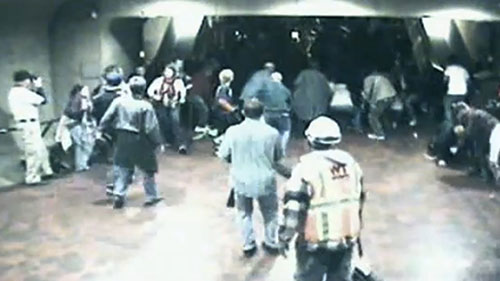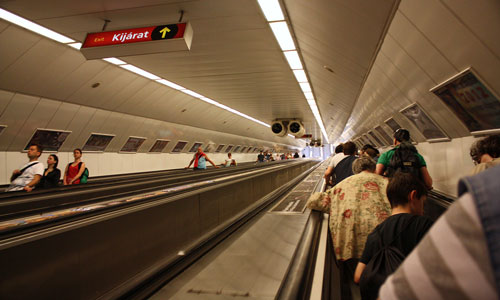An Escalating Danger
Mitch Hedberg's famous joke about escalators turning into stairs when they break isn't as funny as it sounds. Why? Because escalators are dangerous.
"The object of the invention is to enable persons to ascend and descend from one story of a building to another, without exerting any muscular strength; the stairs being also capable of being used in the ordinary way, when desired."
— Inventor Nathan Ames, describing the primary use of his revolving stairs, which he first patented in 1859. (Ames, who died in 1865 at age 38, never got around to building one himself; Jesse Reno was the man who successfully got the device off the ground in 1891.) Despite Ames' claim all those years ago, safety experts have slowly moved away from the idea that a turned-off escalator is actually just as effective as a stairwell, due to small differences in the way the level-movers work. For example, safety materials by the Elevator Escalator Safety Foundation call the stairs-but-not-really thing a myth. "Escalator steps are not the correct height for normal walking, and should not be used in that manner. The risk of falling and tripping is increased," a facilitator guide states. Sounds like an invention that got away from its inventor.

The near-tragedy at The Rally to Restore Sanity and/or Fear
Wanna feel old? Here ya go: just about five years ago, Jon Stewart and Stephen Colbert held one of their most famous events at the Washington Mall. The Rally to Restore Sanity and/or Fear, as it was eventually called, was one of the buzziest events to fill the Mall in years. These days, however, most of the on-air personalities involved in producing it don't work for Comedy Central. Talk about a sea change.
This isn't really about that. Rather, this is about what happened when people were heading home from that day of liberal politics and patriotism—specifically, an escalator accident. As the event ended, people streamed towards the many metro stations that surround the National Mall.
People loaded up the escalators, pushing them to their limits. One such escalator, at the L'Enfant Plaza station, gave out, pushing a sea of humans to the bottom in a display that may scare you out of getting on an escalator for a while.
Six people were injured; many found themselves going to a local hospital instead of getting on a train.
"It was just very chaotic," Leslie Tufarolo, one of the passengers on the escalator that day, told NBC Washington of the incident upon the release of the dramatic video. "I am surprised that more people did not get hurt."
For DC residents, escalator mishaps are common, though not nearly this dramatic. That's because there are hundreds of escalators throughout DC's metro system, way more than any other system in the United States. And the escalators, some of which are more than 200 feet high and see outdoor foot traffic which they were never designed for, break—often.
Washington Metropolitan Area Transit Authority, the DC metro transit organization, is trying its best to learn about the creaky system it runs. It has a lab for better understanding the escalator system, something that helped them diagnose and prevent more incidents like the one that turned the Rally to Restore Sanity into the Rally to Repair Escalators.
But with nearly 600 escalators to maintain, they'll never solve the system's many problems.
“Unfortunately, our system is such a size that to keep it in a state of good repair means we’re going to have to continually rehab escalators,” Rodrigo Bitar, who heads up the organization's escalator repairs, noted in a 2012 Washington Post article on the matter.
12,774

Boy, that escalated quickly: The moving walkways in Budapest
Most escalators move at a speed that would be best described as a slow walking speed at best. But if you're in the metro system in Budapest, Hungary, you might find yourself wishing you had a seat belt.
The reason is that they move really freaking fast compared to the rest of the world, to the point that if a company in another country ran its escalators nearly as fast, they'd be sued. To compare, here's a video of the longest escalator in Washington DC's metro system; now here's an escalator in Budapest doing the same thing.
Pretty fast, huh? Some TripAdvisor commenters have taken to referring to the pace of Budapest escalators as "Communist" speed, which makes sense because Moscow escalators used to be nearly as fast before they started getting replaced.
That high speed hasn't stopped some from being totally reckless on the Budapest stairwells. Back in 2010, for example, a stuntman decided to ski down an escalator at one of the stations, which was the weirdest thing to ever happen in Budapest until they put in the Colombo statue.
But if you're traveling to Hungary's largest city, a word of advice: don't be a hero. It's OK to stand in place.
Mitch Hedberg would probably go crazy in Japan, where campaigns have been launched in recent years to discourage people from walking up escalators, no matter which side of the escalator you're on.
“The habit of leaving one lane open for those to walk up is dangerous for commuters who physically cannot leave a lane open,” the East Japan Railway Co. wrote in a news release, according to the Wall Street Journal.
On the other hand, these campaigns appear to have proven unsuccessful with Japanese riders, who have chosen to stick with the traditionally popular "stand on the right, walk on the left" escalator approach—which is how most of the world does it these days.
If you're gonna recalibrate an entire world taught that escalators are stairs that move, you're gonna have to take things one step at a time.
:format(jpeg)/2018/04/ceeo8y0r7ms7q3libtl6.gif)
/2018/04/ceeo8y0r7ms7q3libtl6.gif)

/uploads/ernie_crop.jpg)